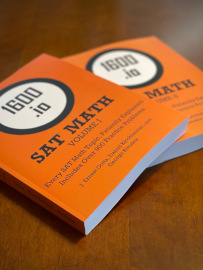1600.io SAT Math Orange Book is a two-volume set of books that has a combined total of over 800 pages. The two books are also available in an interactive, PDF format.
1600.io SAT Math Orange Book is designed to help students do well on the math portion of the SAT® exam, but these books differ in approach from many other SAT prep books. Based on the three authors’ experience in preparing students for the SAT, the books are a distillation of what they have determined to be the best strategies for test preparation. Instead of teaching specialized tricks and strategies, they focus on making sure students are well equipped with actual knowledge of the required math skills and have had plenty of practice in solving problems. The books do point out some peculiarities of the SAT test, but that’s not the primary focus.
The first volume begins with a review of foundational math skills that are prerequisite for solving problems in the other chapters (and on the test). The next 20 chapters address individual math topics, beginning with linear relationships and slope-intercept form, and continuing through topics such as systems of linear equations, solving quadratic equations, graphs of quadratic equations and polynomials, exponential relationships, statistics, and circles and volume. The final chapter deals with problems the authors call “wormholes.” These are “a class of math problems that have a non-obvious, accelerated solution” that students should be able to solve quickly if they are familiar with them (p. xv). The authors insist that learning about wormholes isn’t a test-taking trick, but rather a test of a student’s ability to spot easier solutions that others might miss.
Most chapters include SkillDrills™ that quiz students on the subskills needed to solve the more complex problems in each chapter.
Chapters include explanations of concepts, sample problems, fully-worked solutions, and a number of small sets of practice problems. They also have a list within each chapter showing all related problems from released versions of official SAT exams, so students can practice with actual test problems. Every chapter concludes with a larger set of about 20 additional problems and answer keys for all types of problems in that chapter.
Notes scattered throughout the chapters suggest practical strategies for problem-solving that students should apply anytime they are working on that type of problem. Some of the notes are cautions based on the typical errors that students tend to make.
While students might write in the books, they would probably do better writing elsewhere so they can show all of the steps in their problem-solving. This helps if they need to go back to find where they went wrong.
There are no full-length tests in these books, but the publisher’s website offers a free bundle of four official SAT practice tests with answer forms, and expert analysis of every question. The website also has dozens of free videos that offer another way to learn topics addressed in the books. Access to all of their videos (hundreds of hours) is available for a monthly or yearly fee.
The books can be used in a number of ways. They are not intended to substitute for the pertinent math courses, but they briefly reteach the main concepts students should have learned. While a student can just work through the books cover to cover, they might study only chapters on selected topics. Most chapters have a recap of key concepts immediately before the set of additional problems, and a student might review the recap to identify anything with which they are not familiar. They might also take an SAT test and identify the types of problems they need to focus upon. At the back of the second volume of 1600.io SAT Math Orange Book, is a multi-page set of charts identifying math problems on all released SAT practice exams and the corresponding pages in these books where that type of problem is covered.
You can view a few sample pages on the publisher's website.
Summary
1600.io SAT Math Orange Book is a very thoughtfully designed approach for test preparation that should actually improve students’ math skills rather than just teach them test-taking strategies. The variety of ways in which the books can be used also makes them readily adaptable for students working at different proficiency levels.










